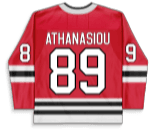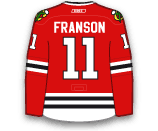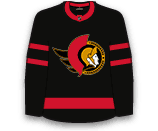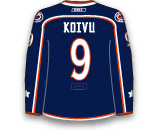


Atkinson’s extension include a no-trade or no-move clause in the first two years of the deal and a limited no-trade after that. Atkinson had a breakout campaign in 2016-17 but has struggled early-on in 2017-18, collecting just four goals and two assists (six points) in 15 games. Regardless of the slow start, Atkinson is locked into a large role in the Blue Jackets offence and is now signed there through the 2024-25 season.

Polak appeared in 75 games with the Maple Leafs last season, posting just 11 points (4G / 7A) and averaging 17:55 TOI/GM—including a team-high 2:54 TOI/GM on the penalty kill. The Maple Leafs have been leaning heavily on Ron Hainsey and Nikita Zaitsev on the PK, so Polak has likely been signed to ease that burden on those two.


Matheson, 23, was the No.23 pick in 2012 and has become a big part of the Panthers’ blueline, averaging over 21 minutes per game last year and through the first two games of this season. He has some offensive ability to his game and should be able to top his 17 points (7G / 10A) from last season.

Pirri has proven to be a quality goal-scorer throughout his career, but hasn’t really been put in opportunities to succeed in recent years. Pirri had 22 goals in 49 games with the Panthers in 2014-15 and is coming off of a season where he tallied eight goals and 10 assists (18 points) in 60 contests with the Rangers.

Borowiecki, 28, does not being a lot of fantasy value to the table unless you are in a hits league. In 2016-17. Borowiceki led the league in hits (364) last season, but had just one goal and two assists.

Winnik is expected to make his Wild debut on Thursday after earning a contract on a PTO during training camp. Winnik is coming off of a year in which he had 12 goals and 13 assists (25 points) in 72 games with the Capitals. Look for him to skate with Matt Cullen and Tyler Ennis on the Wild fourth line in his debut.

Chiasson, 27, spent last year in Calgary after two years in Ottawa and had 12 goals and 12 assists (24 points) in 81 games. Chiasson will make his Capitals debut on the third line while Tom Wilson is suspended.

The Blackhawks had to wait until they moved Marian Hossa to LTIR to announce the deal, but they bring Franson to join a mostly inexperienced blueline. Franson spent the last two seasons with the Sabres, where he had five goals and 19 assists (24 points) per 82 games, but missed a combined 37 games. His value will hinge on how much power-play time he gets in Chicago.

Ehlers is entering the final year of a three-year deal, so this new deal won’t kick in until 2018-19 and it runs through the 2024-25 season. The 21-year-old is coming off of a great sophomore campaign, having collected 25 goals and 39 assists (64 points) in 82 games. Ehlers is positioned for another great year as he’s poised to start the season with Patrik Laine and Bryan Little.

Eichel is entering the final year of his entry-level contract, so this extension will kick in for the 2018-19 season and run through the 2025-26 campaign—he will be 29-years-old. Eichel is hoping for a better start to 2017-18 after last year got derailed by an injury before the first game. Upon his return to the Buffalo lineup, Eichel was 10th in the NHL in points and is pegged as one of the biggest breakout candidates coming into this season.

Glass signs on with the Flames to be a depth forward after a solid training camp. The 33-year-old winger offers nothing in terms of fantasy value, having picked up just 69 points (24G / 45A) in 511 career NHL games.

Anderson held out of training camp as an unsigned RFA, but gets a contract one-day before the start of the NHL season. The 23-year-old is coming off of 17-goal, 12-assist season and will look to carve out a larger role this season. Missing training camp will put Anderson behind the 8-ball and likely force him to start the season in the bottom-6.

After a summer of hilarious Tweets and patiently waiting, Jagr has signed on with the Flames two days prior to the start of the season. The 45-year-old veteran appeared in all 82 games last season, posting 16 goals and 30 assists (46 points) with the Florida Panthers. Jagr will likely play be limited to a bottom-6 role to start, but could work his way up the depth chart in a hurry.

Anderson was entering the final year of a three-year deal but is now signed through the 2019-20 season. Anderson is coming off of a tough off-the-ice season, but played spectacularly in his 40 starts, going 25-11-4 with a 2.28 GAA, .926 SV% and five shutouts. As long as everything goes well, Anderson should get back to 50-plus starts and could approach 30 wins, making him a solid No.2 fantasy option.

Koivu was heading into the final year of his seven-year contract that carries a $6.75M cap-hit, but the Wild inked the 34-year-old to a deal that will take him through the 2019-20 season. The Wild captain had 18 goals and 40 assists (58 points) in 80 games last season and is tied for 30th in the NHL in assists (113) and tied for 45th in points (162) while only missing four games over the last three seasons.

Pastrnak was back in the Czech Republic and was gearing up to skate with a team there if he didn’t get a new deal in Boston. GM Don Sweeney held his ground and got a good deal for both sides and now one of their top offensive weapons will report to training camp. Coming off of a 70-point (34G / 36A) campaign, the 21-year-old enters 2017-18 with huge expectations. Look for him to be a point-per-game player.

Little was entering the final year of a five-year deal with a $4.7M AAV, so the 29-year-old centre gets a bit of a raise starting in 2018-19. Little has been a strong playmaker for the Jets, but has had some concerns over the years, missing 60 games over the last three seasons. If he can stay on the ice, Little has 25-goal, 40-assist upside.

Some of the top NHL free agents available this summer are Mitch Marner, Mikko Rantanen, Aaron Ekblad, Nikolaj Ehlers, John Tavares, Brock Boeser, Brad Marchand and Linus Ullmark.
This offseason will bring a stacked crop of free agents to the market that will shape the landscape of the 2025-26 NHL season. Not only will the final landing spots for each of the top 2025 NHL free agents shake up the framework of the league, but will also have major implications on the upcoming fantasy hockey season. Be sure to stay in the know in regard to the latest free agency updates with our NHL player news.
On July 1st, 2025, at 12 PM EST, the 2025 NHL free agency period officially opens. While some players will have all but signed the dotted line up to this point, nothing can become official until noon on Canada Day.